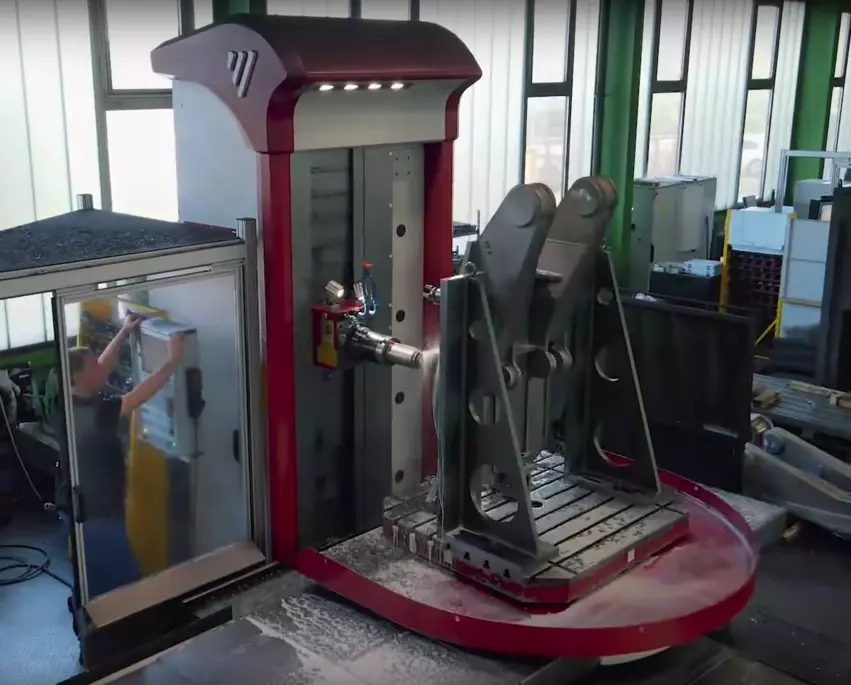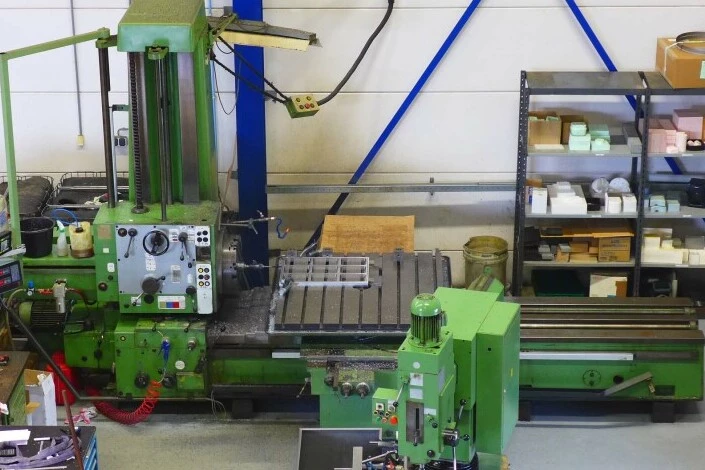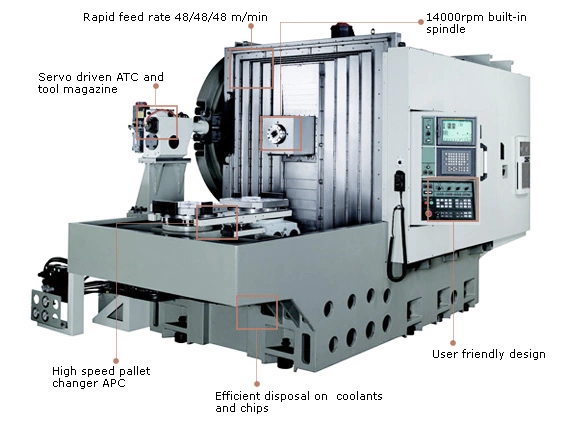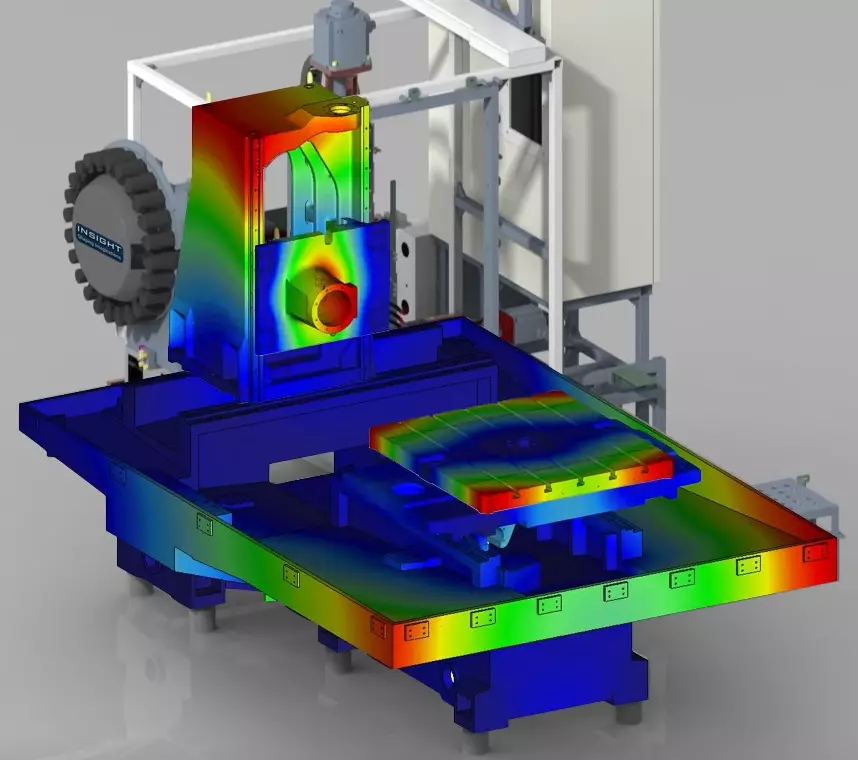1) Introduction to Horizontal Machining Center (HMC)

Horizontal Machining Centers (HMC) are among the most essential computer-controlled machines in the machining industry. Differing from vertical machining centers and universal machining centers, the HMC’s main spindle is oriented horizontally. Due to this horizontal positioning of tools, they can perform deeper machining operations. Tasks like deep hole drilling and broaching are common operations in these centers. Additionally, the sturdy and durable structure of these machines allows for taking deeper cuts.
The tables on these machines are typically rotatable, providing utility for fourth-axis operations where they can be positioned at specific angles. Their elongated horizontal design also features pallet-changing systems. These systems enable the machines to change pallets automatically over extended durations, thereby eliminating the time taken for part clamping.
Especially the pallets with tombstones and clamp towers you can mount a lot of parts in one stop. When one pallet is engaged in machining, another can be prepped in reserve. Thanks to advancing technology, HMCs can also attach or detach portable machining heads. These portable heads can be set at a 90° angle or other specialized configurations for specific machining tasks.

Similar to automatic tool changers, these heads can be installed or removed by an automated system. Since HMCs run for extended periods, they are equipped with backup tool changers to ensure continuity in operations. In case a tool breaks or requires changing, the machine can automatically replace it without manual intervention.
Because advanced features of these CNC machines ensure that horizontal machining centers can efficiently and precisely execute expensive tasks. Therefore, sectors like mold manufacturing, automobile engine production, and aerospace component fabrication heavily rely on these centers.
- 1) Introduction to Horizontal Machining Center (HMC)
- 2) History of HMC and its Development
- 3) Basic Components of an HMC
- 4) Types of HMCs
- 5) Advantages of Using an HMC
- 6) Comparison: HMC vs. VMC
- 7) Practical Applications Of HMC
- 8) Integration and Upgrade Of HMC
- 9) Challenges and Considerations with HMCs
- 10. Tips for Beginners
- 11. Conclusion
In the further sections of this article, we will deep dive into the properties, usage, types, and differences of horizontal machining centers. You can navigate to related articles from the table of contents below.
Also, I had previously written an article about well-known Machining Centers which you can check here.
You can check this article for comprehensive information about VMC(vertical machining centers).
Please check this article for more about the UMC(Universal Machining Center).
2) History of HMC and its Development
The evolution of Horizontal machining centers (HMCs) has its roots in the commonly used horizontal boring, milling drilling machines in the industry, capable of performing similar tasks. The model machine that works in this fashion is mechanically much more advanced than many other conventional machines. With the ability to operate in multiple axes, this type of machine easily handled large parts that were difficult to process before. Today, the advanced structure of these machines has been seamlessly integrated with CNC-driven HMCs.

Historically referred to as ‘Bohrwerk‘, these machines were capable of drilling, milling, and even turning, thanks to an additional counterpart column. In modern, computer-controlled machining centers, this milling and drilling capacity has been directly transferred, though the turning capability has not been carried over.
3) Basic Components of an HMC
a) Structure and HMC design

Horizontal machining centers (HMCs) structurally consist of a large column supporting a block that carries the horizontal spindle. In some HMCs, the spindle is stationary, while in others, it can move forward and backward. There exists a table where parts to be machined are mounted. These tables can be replaced and can also perform fourth-axis movements.
b) Spindle orientation and its benefits:
Due to the spindle orientation being horizontal in HMCs, they possess several advantages in part processing. One of these advantages is known as chip control. Because the part is vertically mounted, chips automatically fall downward due to gravity. This prevents the cutting tool mounted on the spindle from breaking. As mentioned earlier, horizontal configuration can accommodate longer drills and tools.
c) Tool magazines and automatic tool change:
In HMCs, due to the tools being generally large, tool magazines are constructed to carry heavy tools. Some of these are designed as racks, while others can be in the form of chains.
d) Pallet changers and efficient machining:
With pallet changers, the tables in HMCs can be automatically swapped out. One of the reasons for using pallet changers is to ensure the machine can operate continuously without interruptions. When the HMC operates over long durations, the backup table waiting in the pallet changer gets prepped for the next part to be machined.
e) HMC control systems and software:
HMCs come equipped with specially prepared software interfaces. For instance, besides the main CNC controller, a distinct software and human interface are developed for the pallet changer. Additionally, because in HMCs, tool changers are sometimes used as head changers, there are specific software and human interfaces integrated into the machine to switch tools and heads.
4) Types of HMCs
Horizontal machining centers have been manufactured in various forms for multiple purposes. We are going to explore these below;

a) Single-Pallet HMCs:
The single-pallet is one of the simplest types of HMCs. Since it has only one table or pallet, only one part can be mounted for machining at a time.
b) Multi-Pallet HMCs:
The multi-pallet horizontal machining centers possess multiple pallets. These typically range from two to eight, though other combinations are available in the market. With the help of a small robot, these pallets are automatically swapped as the operations are completed.
c) Universal or 5-Axis HMCs:
Due to the complex designs of modern parts, there has been a need for fourth and fifth axes in horizontal machining centers. For this reason, universal horizontal machining centers have been developed. These types of HMCs predominantly use the spindle in a horizontal orientation, and they can also accommodate heads capable of simultaneous multi-axis movement powered by their servo motors.
5) Advantages of Using an HMC
Horizontal machining centers (HMCs) offer several advantages in precision machining. Here’s a detailed look into some of those advantages.
a) Enhanced precision due to rigid structure:
Horizontal machining centers come equipped with cooling systems designed to enhance thermal accuracy. This allows for machining parts at the highest quality.
b) Efficient chip evacuation because of gravity:
Due to their horizontal orientation, HMCs automatically dispense chips onto chip conveyors. Gravity assists in automatically guiding the chips to chip conveyor systems, and the coolant fluid continually flows over the part and is channeled through the coolant transport system.
c) Ability to handle larger, bulkier parts:
HMCs, being sturdier and more robust, have the capacity to carry and machine larger parts. With their rotating tables, once a part is secured, it can be machined from multiple sides without the need to unmount and reposition. This allows large parts to be mounted once and finished in a single setting, providing significant efficiency.
d) Multi-sided machining without repositioning:
Thanks to rotating tables, once a part is mounted on an HMC, multiple surfaces can be machined at various angles without the need to reposition the part.
6) Comparison: HMC vs. VMC
When comparing Horizontal Machining Centers (HMCs) and Vertical Machining Centers (VMCs), several distinctions emerge that can influence the choice between the two:
- Spindle Orientation: The spindle in an HMC is horizontally oriented as opposed to the vertical orientation in a VMC. This allows for the use of heavier cutting tools and portable heads in HMCs.
- Functional Advantages: HMCs offer numerous benefits over VMCs. Due to features like efficient chip evacuation systems, pallet changing systems, and backup tool changers—features not commonly found in VMCs—HMCs are often considered more versatile.
- Choice Based on Project Needs: If the machining of larger parts is required, then HMCs should be preferred. Additionally, if an operator-free machining process is being planned, HMCs should be chosen due to their more efficient systems in this regard.
7) Practical Applications Of HMC
Industries that predominantly use HMCs, such as aerospace, automotive, and medical devices are at the forefront of using HMCs. These sectors value the precision and efficiency that Horizontal Machining Centers offer.
When it comes to types of components best suited for a Horizontal Machining Center machine there is a wide range of parts that can be machined. Specifically, Engine blocks, aerospace parts, and complex medical devices appear. These components benefit from the multi-sided machining capabilities of HMCs, ensuring high-quality results.
8) Integration and Upgrade Of HMC
One of the most notable HMC upgrades is the integration of robotics for automated loading and unloading of components. This automation in HMC not only enhances efficiency but also minimizes manual intervention, thereby reducing the risk of errors.

Modern HMC features now include advanced probing and measurement systems. Probing systems provide real-time data. Real-time can be used for the real-time feedback system to ensure precision and cutter quality.
9) Challenges and Considerations with HMCs
a) Initial Investment and Space Requirements:
One of the primary challenges with HMC is the initial investment. These machines are not inexpensive. Additionally, they require ample floor space, adding to the overall cost of HMC.
b) Training and Skill Requirements for Operators:
Another consideration is the need for skilled operators. Training is essential, and the skills for HMC operation are specialized. This aspect further contributes to the operational costs.
c) Maintenance and Upkeep Considerations:
Lastly, maintenance can’t be overlooked. Regular upkeep is vital for the machine’s longevity. Therefore, HMC maintenance is another factor that adds to the total cost of ownership.
10. Tips for Beginners
a. Factors to Consider When Investing in an HMC
For those starting with HMC, initial investment is key. It’s not just the machine’s cost but also the space it takes. Plan your budget and workspace well when investing in HMC.
b. Importance of Operator Training and Continuous Learning
Operator training is ongoing, not a one-off. Learning about HMC is vital for top performance. Skilled operators make a big difference in output and efficiency.
c. Emphasis on Regular Maintenance for Longevity and Precision
Lastly, don’t skimp on regular upkeep. Caring for your HMC ensures its long life and precision. Regular maintenance checks can prevent costly downtimes.
11. Conclusion
In conclusion, as you see Horizontal Machining Center is a serious, heavy, and expensive machine. All this seriousness comes with a lot of positives like being able to machine large parts and using a palette changer to increase efficiency.

